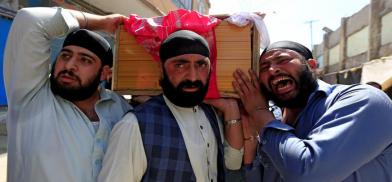Afghanistan a dangerous place for religious minorities, particularly Sikhs
Afghanistan has become an extremely dangerous country for its residents, especially religious minorities. After surviving there for hundreds of years, the Sikhs virtually don’t even have a right to exist anymore, writes Sanchita Bhattacharya for South Asia Monitor

On March 25, in a fidayeen attack, gunmen and suicide bombers stormed a Sikh gurdwara in the heart of Afghanistan’s capital Kabul, killing at least 25 worshippers and wounding eight others, in one of the deadliest attacks on the minority community in the country. Around 150 people were reportedly worshipping in the gurdwara at the time of the attack. All four terrorists were killed by Afghan security forces. Kabul Police said at least 11 children were rescued from the gurdwara. The ISIS-Khorasan claimed responsibility for the attack. However, the Ashraf Ghani government blamed the Pakistan-backed Haqqani network for the terror attack. The Taliban denied involvement in the attack.
As the Afghan Sikh population is dwindling, there are varying reports about the exact numbers of remaining functional gurudwaras in Afghanistan. In 2018, the Australian Institute of International Affairs noted that there were only two remaining operational gurdwaras in the country: one in Kabul, another in Jalalabad. However, the British Embassy in Kabul claimed there were 65 gurdwaras in Afghanistan in 2019. Most are in derelict condition and some have been razed in rocket attacks. So, there are only two functioning gurdwaras in Kabul and Jalalabad. And two partially functioning in Jalalabad and Ghazni.
Afghan Sikhs have faced widespread discrimination in the country at the hands of Islamic militants. Earlier, in July 2018, a convoy of Sikhs and Hindus was attacked by an IS suicide bomber while on their way to meet Afghan President Ashraf Ghani in Jalalabad. That attack killed 19 people. Avtar Singh Khalsa, a leader of the Sikh community who planned to run in the parliamentary elections that October, was also killed in the attack. The ISIS- Khorasan had, in a letter, issued a threat to Afghan Sikhs and Hindus and told them to pay jizya (a tax levied on non-Muslims in an Islamic state), the letter also said that if Afghan Hindus and Sikhs failed to pay the tax, they would have to face consequences.
The ill-effect of years of Taliban rule and the changing nature of the Afghan social fabric vis-à-vis its religious minorities can be exemplified in the mass exodus of Sikhs from Helmand Province. As Afghan society became more intolerant with years of Taliban rule, the end of their rule did not help the Sikhs. The regular harassment they faced from common people, and not extremists, forced the Sikh exodus from Helmand. After September 2018, Sikhs who lived in more isolated areas in Helmand largely either moved to other cities or left Afghanistan. Until a few years ago, there was still a tiny community of Sikhs in Lashkar Gah, the provincial capital. During the Taliban regime, about 60 Sikh families lived in Lashkar Gah. They held out there despite the Taliban’s extremist Islamist rule, which forced non-Muslim Sikhs to identify themselves by wearing yellow patches. But the situation worsened after the Taliban was overthrown. The exodus of Lashkar Gah’s Sikhs only began after the overthrow of the Taliban regime by the US-led intervention, which was supposed to bring greater freedom for all Afghans, including the minorities.
Prior to the 1990s, Afghanistan’s religious minorities, including the Sikhs, were enabled enough to be a part of the military and civil services, and some even held high positions in banking. The situation became grim from the Taliban era and the continued violence of the following decades. At present, though the constitution expressly protects freedom of religion for non-Muslims within the limits of the law, these freedoms are limited in practice. The Penal Code also provides punishments for anyone who prevents a person conducting their religious rituals or rites; damages places of worship; and for attacking followers of any religion. Unfortunately, Sikhs and Hindus still face discrimination, intimidation, harassment, pressure of conversion and violence.
The government has been ineffective in protecting minorities from harassment. Religious practices of Sikhs such as cremation of the dead are limited or restricted by local authorities and the public. Sikhs in particular have had their hair forcefully cut as a specific act of religious violence. Often, their houses and properties are illegally taken by others and the government does nothing to help. Unfortunately, Sikhs cannot demand the same protections that others enjoy because they are too small numerically to matter politically. Sikhs also face the growing threat of extortion and torture.
The Sikh community is now based in three main cities: Kabul, Jalalabad and Ghazni. There are also some businesses operated by them in other places, like Kandahar. Prior to the collapse of the pro-Soviet regime in 1992, there were approximately 200,000 members of the Hindu and Sikh communities.
The US Department of State’s International Religious Freedom Report for 2017 (USSD IRF Report 2017), published in May 2018, noted that, of Afghanistan's total population of 34.1 million, non-Muslim religious groups, mainly Hindus, Sikhs, Bahais and Christians, constitute less than 0.3% of the population. Sikh and Hindu leaders estimate that there are 245 Sikh and Hindu families, totaling around 1,300 people, still residing in Afghanistan.
According to the Global Peace Index 2019, Afghanistan ranks lowest, in 163rd position. Afghanistan has become an extremely dangerous country for its residents, especially religious minorities. After surviving there for hundreds of years, the Sikhs virtually don’t even have a right to exist anymore. In February 2020, Afghanistan’s Ministry of Finance allocated USD 650,000 to renovate Hindu and Sikh community temples across the country. But, at the ground level, the government needs to do more to protect the rights of religious minorities; help with building schools, providing health facilities, creating job opportunities and giving them placements in the government. If Afghanistan wants to portray itself as a contemporary and progressive nation, then the issue of minority protection should be one of its priorities.
(The writer is Research Fellow, Institute for Conflict Management, New Delhi)










Post a Comment